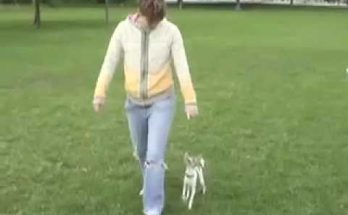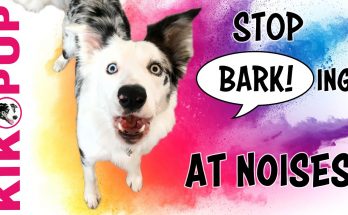Visit our website: http://dogmantics.com/
Visit our storek: http://dogmantics.com/shop/
Become a fan on facebook:
http://www.facebook.com/pages/Dogmantics-Dog-Training/75289166216
SUBSCRIBE TO THIS CHANNEL TO SHOW YOUR SUPPORT! We appreciate it:
http://www.youtube.com/subscription_center?add_user=kikopup
Positive Interrupter Noise/Attention Noise-
This is a noise that always sounds the same and means "stop what you are doing and look at me". The difference between a recall and a positive interrupter is with a recall you want your dog to come running to you, while with the positive interrupter you want your dog to stop doing what he is doing, so you can give him an alternate behavior to do in place of the one you don't like. An example: your dog is chewing on the wall; you can make a kissy noise and direct the dog to his chew toys.
Having a noise that always sounds the same to get your dogs attention or interrupt
unwanted behavior is easier to condition than using the dog's name. I like to use a
kissy noise or a whistle. You can condition this noise to the point of muscle
memory- red light stop, green light go, when you make the noise your dog stops what he
is doing and looks at you reflexively.
This noise is great for interrupting your dog from "staring" at other dogs or interrupt your
dog from being spooked by another dogs staring. If you were to say "hey!" or "No!" not
only do you startle your dog while he is worried about the other dog (creating more
tension and arousal) but you also "pair" punishment with the other
dog, which is not a great way to make the other dog seem reinforcing!
Video tutorial on how to teach the Positive Interrupter noise:
(Attention away from distractions shows up in the attention video at 4.15 mins into the video)
Exercise 1: Click your dog for voluntary eye contact. Anytime your dog looks at you click and reward. This is to condition looking at you to be reinforcing.
Exercise 2: Condition your interrupter noise. Make the noise (a kissy noise or a whistle), pause, and then move to feed your dog a treat. Do this until the dog is perking up when he hears the noise (similarly to a clicker), if your dog is not paying attention to the noise it could mean the treats you are using are not reinforcing or the dog is stressed or distracted by the environment). You want to work on this very important behavior in a non-distracting environment to build a strong foundation before moving on.
Exercise 3: Make the interrupter noise and 'click' or say 'yes' for eye contact. If the dog doesn't look you can try making a blowing noise to get your dog to look up at you- don't actually blow at your dog or your dog might be tempted to bite at the air… you will be just making a strange noise to initiate eye contact that you can click.
Exercise 4: Next step, make the noise while your dog is looking the other way, CLICK when the dog orients towards you, and FEED. Don't forget you can also praise your dog after you click. You can ask for longer and longer periods of eye contact if you wish. Once your dog is turning around every time you can click for eye contact rather than then initiation of the dog turning around.
Exercise 5: Proof the interrupter noise by having the dog on leash and on a harness with a distraction ahead (perhaps a toy just out of reach, or a treat just out of reach) make your noise and CLICK when the dog turns their head to look at you. Once your dog is turning reliably you can click for the dog turning and then making eye contact. You will find if you are doing it correctly, that the dog will seem to no longer want to pull towards the distraction, even avoid it. Now start proofing with higher-level distractions, and proofing in different locations. If for some reason the dog doesn't turn back towards you. You can work more on conditioning the noise, as well as start off further away from the distraction. If you make a mistake and start too close, simply back up, without jerking the dog, using gentle even pressure to move further away from the distraction to the point where your dog can be successful.
Remember, don't ONLY make the attention noise around things your dog doesn't like or is fearful of, or you can poison the cue. Your dog can learn to associate the noise with the "presence of something he doesn't like", so if you are using the noise for a shy or reactive dog make the noise to get your dogs attention away from food, smells and people or dogs he likes as well.
"Dog Training" "Clicker Training" "How to train a dog" "train your dog to pay attention" "puppy training tips" "Dog training Tips" "Expert dog training" "Professional Dog Training" "Dog trainer" "Professional dog Trainer" Puppy training basics





Thanks so much for posing this, Emily. Your timing is terrific as I was just trying to explain this to my 4-H dog kids yesterday. Now, I can refer them to your video so they can see it in action! Barb F – SW KS, USA
Thanks to Emily (Kikopup), the positive interrupter was the BEST tool ever during my very busy puppies childhood! It works wonders.
THANK YOU!! I just got a pet German shep. and these videos are very useful
oh.my.gosh. that puppy was just the cutest.
The puppy didn’t even notice all the treats that had fallen on the floor… it must be that default leave it. 🙂
is it ok if i use a ball point pen to click instead? Those clickers are very expensive in my country
@kikopup
Amazing as always!
But could you please make a video about how to train a dog to do not fear about noises? Like for example a gun shot?
That would be amazing! Thank you for your great job!
Just an aside about the adorable expressiveness and attention level of this puppy. I couldn’t get my male springer to engage eye contact for months. It was such a struggle with him. Some pups are just hard-wired to enage more than others. Oddly, though, I’m going to do this exercise with my adult dogs, who are getting training at a basic level again. It’s good to do some of these as refeshers if you are having other behavioral issues.
@langleywrite Totally 🙂 I need to remember to refresh basic eye contact with Tug every once in a while!
@ClickerPets I wish! Actually the puppy is still so young, that he is a little slow at finding the treats! He was 6 weeks I believe when I filmed this ( a foster puppy). It took him a while to figure out where the treats were in my hand too when I would hold them out to him!
when you training them what treat do you give them?
What do you use for your clicker? Your videos are great! I plan on using your techniques for a stray that found me. 🙂
i was already surprised at how long u got the puppy to stay there for more than a second, lolol
I tell everyone who asks me about training their new puppy to watch your videos as they just were so helpful to me, you are such a fantastic dog trainer.
That puppy is adorable! How old is he?
Excelente vídeos nice . Saludo desde Jalisco México
I had no idea staffies were so darn CUTE!
@kikopup I understand keeping the training sessions short but how long can I go between training sessions in a day? I will be getting a new puppy in a few weeks. Also, is there anything I can do to positively enforce the first ride home (less than two hours)?
I trained my first dog really successfully with the clicker (thanks to Kikopup!) but my new pup (GSP 10 weeks old) is a totally different story and I’m starting to worry. The problem is that she almost entirely ignores all sound cues. I’ve been working at it for 3 days now several times per day and it’s still pretty random that she looks at me when I make a noise of any sort. I’ve tried doing different noises (kissing, clicking, whistling, blowing etc) and although she’s learned to watch my hand for sit, down, not bugging my hand for treats, she only gives eye contact when the treat doesn’t come. I’ve tried to make the association by only making a sound when I get eye contact and then rewarding but she’s still only giving eye contact eventually and rarely when I make a sound. The vet checked her ears yesterday and said her ear drums are intact and since she does respond to some sounds (clapping, eh-ah if something is wrong) so I just don’t know where to go next. Any advice gratefully appreciated……
My puppies eyes are so dark it’s hard to tell when she is looking into my eyes.